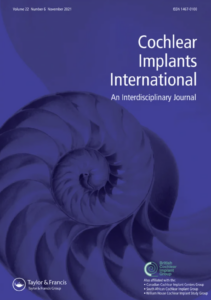Cochlear implants
Publication Types:

Cochlear implantation: Exploring the effects of 3D stereovision in a digital microscope for virtual reality simulation training - A randomized controlled trial
Background: In cochlear implantation (CI), excellent surgical technique is critical for hearing outcomes. Recent advances in temporal bone Virtual Reality (VR) training allow for specific training of CI and through introduction of new digital microscopes with ultra-high-fidelity (UHF) graphics. This study aims to investigate whether UHF increases performance in VR simulation training of CI electrode insertion compared with conventional, screen-based VR (cVR).
Methods: Twenty-four medical students completed a randomized, controlled trial of an educational intervention. They performed a total of eight CI electrode insertions each in blocks of four using either UHF-VR or cVR, in randomized order. CI electrode insertion performances were rated by two blinded expert raters using a structured assessment tool supported by validity evidence.
Results: Performance scores in cVR were higher than in the UHF-VR simulation although this was not significant (19.8 points, 95% CI [19.3-20.3] vs. 18.8 points, 95% CI [18.2-19.4]; P = 0.09). The decisive factor for performance was participants’ ability to achieve stereovision (mean difference = 1.1 points, 95% CI [0.15-2.08], P = 0.02).
Discussion: No additional benefit was found from UHF-VR over cVR training of CI electrode insertion for novices. Consequently, standard cVR simulation should be used for novices’ basic skills acquisition in CI surgery. Future studies should instead explore the effects of other improvements in CI surgery training and if the lacking benefit of UHF-VR also applies for more experienced learners.
Conclusion: The increased graphical perception and the superior lifelikeness of UHF-VR does not improve early skills acquisition of CI insertion for novices.
Keywords: Cochlear implantation; Simulation-based surgical training; Virtual reality simulation.

Cochlear implant surgery: Virtual reality simulation training and transfer of skills to cadaver dissection—a randomized, controlled trial
BACKGROUND: Cochlear implantation requires excellent surgical skills; virtual reality simulation training is an effective method for acquiring basic competency in temporal bone surgery before progression to cadaver dissection. However, cochlear implantation virtual reality simulation training remains largely unexplored and only one simulator currently supports the training of the cochlear implantation electrode insertion. Here, we aim to evaluate the effect of cochlear implantation virtual reality simulation training on subsequent cadaver dissection performance and self-directedness.
METHODS: This was a randomized, controlled trial. Eighteen otolaryngology residents were randomized to either mastoidectomy including cochlear implantation virtual reality simulation training (intervention) or mastoidectomy virtual reality simulation training alone (controls) before cadaver cochlear implantation surgery. Surgical performance was evaluated by two blinded expert raters using a validated, structured assess- ment tool. The need for supervision (reflecting self-directedness) was assessed via post-dissection questionnaires.
RESULTS: The intervention group achieved a mean score of 22.9 points of a maximum of 44 points, which was 5.4% higher than the control group’s 21.8 points (P = .51). On average, the intervention group required assistance 1.3 times during cadaver drilling; this was 41% more frequent in the control group who received assistance 1.9 times (P = .21).
CONCLUSION: Cochlear implantation virtual reality simulation training is feasible in the context of a cadaver dissection course. The addition of cochlear implantation virtual reality training to basic mastoidectomy virtual reality simulation training did not lead to a significant improvement of performance or self-directedness in this study. Our findings suggest that learning an advanced temporal bone procedure such as cochlear implantation surgery requires much more training than learning mastoidectomy.

Cochlear Implant Surgery: Learning Curve in Virtual Reality Simulation Training and Transfer of Skills to a 3D-printed Temporal Bone—a prospective Trial.
Objective: Mastering Cochlear Implant (CI) surgery requires repeated practice, preferably initiated in a safe – i.e. simulated – environment. Mastoidectomy Virtual Reality (VR) simulation-based training (SBT) is effective, but SBT of CI surgery largely uninvestigated. The learning curve is imperative for understanding surgical skills acquisition and developing competency-based training. Here, we explore learning curves in VR SBT of CI surgery and transfer of skills to a 3D-printed model.
Methods: Prospective, single-arm trial. Twenty-four novice medical students completed a pre-training CI inserting test on a commercially available pre-drilled 3D-printed temporal bone. A training program of 18 VR simulation CI procedures was completed in the Visual Ear Simulator over four sessions. Finally, a post-training test similar to the pre-training test was completed. Two blinded experts rated performances using the validated Cochlear Implant Surgery Assessment Tool (CISAT). Performance scores were analyzed using linear mixed models.
Results: Learning curves were highly individual with primary performance improvement initially, and small but steady improvements throughout the 18 procedures. CI VR simulation performance improved 33% (p < 0.001). Insertion performance on a 3D-printed temporal bone improved 21% (p < 0.001), demonstrating skills transfer.
Discussion: VR SBT of CI surgery improves novices’ performance. It is useful for introducing the procedure and acquiring basic skills. CI surgery training should pivot on objective performance assessment for reaching pre-defined competency before cadaver – or real-life surgery. Simulation-based training provides a structured and safe learning environment for initial training.
Conclusion: CI surgery skills improve from VR SBT, which can be used to learn the fundamentals of CI surgery.
